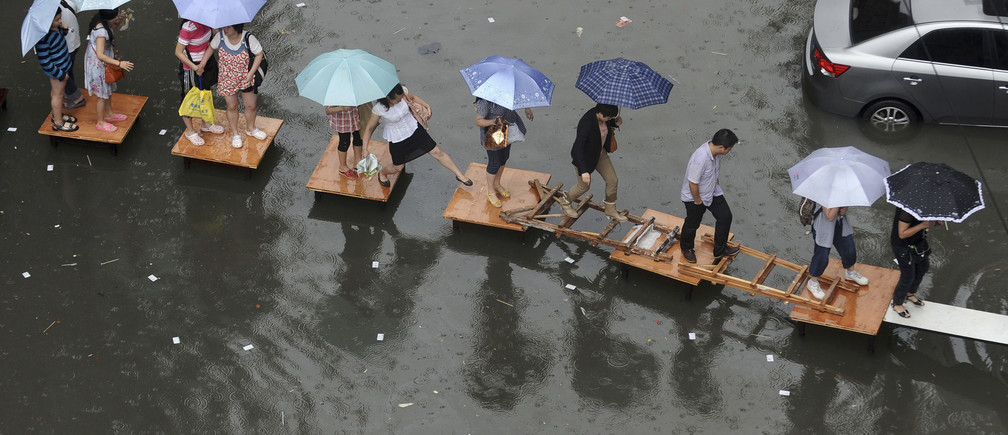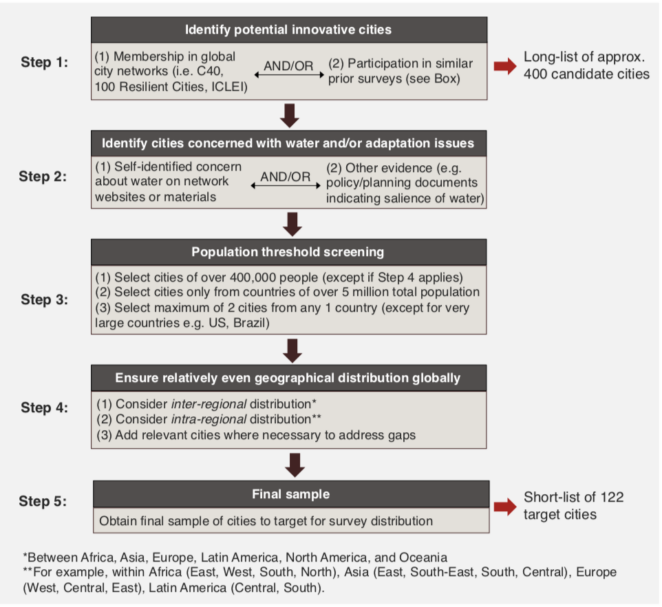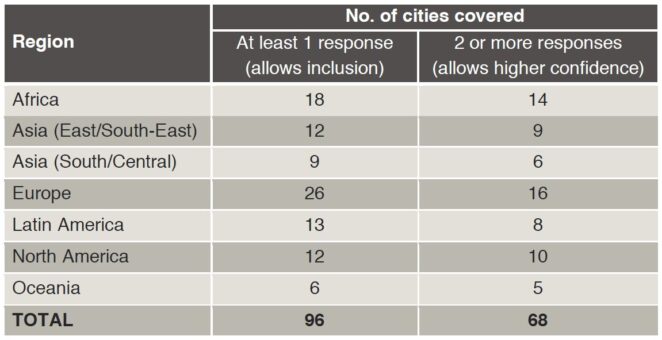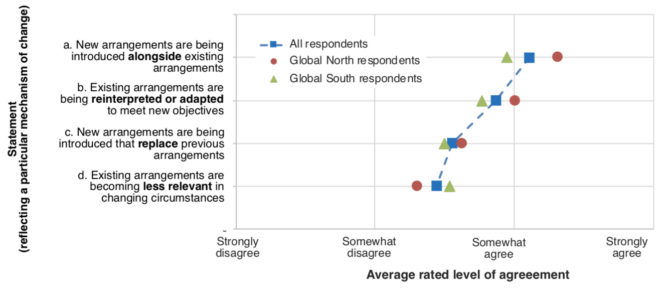Cities adapting to climate change: InnovCities survey findings on institutional innovation in urban governance

Introduction
Cities face a myriad of chronic and acute climate risks, many of which intersect with water governance and infrastructure. Moreover, evidence suggests that governance is a key contributor to whether or not water is sustainably and effectively managed (Pahl-Wostl et al. 2012). In order to address governance weaknesses and gaps, it is first necessary to explore what contributes to agile institutions that can proactively adapt as climate conditions change and knowledge of the future climate grows.
“Institutions are the rights, rules and procedures that influence how multiple actors interact to make decisions and take action. This can include policies and laws, organizational setups, and coordination arrangements.” (InnovCities report, p.II)
To address this, InnovCities conducted a survey of 96 cities to investigate institutional innovation around urban water governance and the factors which may influence different avenues of innovation.
“Institutional innovation in the context of this report refers to intentional changes in institutions that allow a city to better deal with climate change. This could include:
- Changes in policy and legal frameworks that structure decision-making,
- Changes in policy instruments for implementation,
- Changes in organizational setups to meet new objectives, and
- Changes in coordination arrangements between different actors.” (p.2)
This report* discusses findings of the survey and its implications for other cities. The specific focus is on the following:
- The level of concern about various water-related issues under climate change;
- The general orientation of adaptation issues within cities;
- How experiences of climate disturbances have impacted support for urban water adaptation;
- What governance aspects were considered important for urban water adaptation; and
- The types and processes of institutional innovation.
*Download the full report from the right-hand column. An overview of the report is provided below – see the full text for much more detail. Also available in Spanish.
Methodology
The survey methodology built upon previous work by the OECD (2016); Aylett (2014) and Bulkeley & Castán Broto (2013). The cities were selected based on (1) the potential to be innovative (2) population size and (3) global geographic distribution. An initial list of 400 cities was narrowed down to 122, with attention paid to ensuring relatively even geographic distribution of chosen cities across six geopolitical regions.

Following city selection, the author compiled a list of contacts deemed to be key informants in the study area. Approximately 16 contacts per city (a total of approximately 2000 experts) were contacted, and survey sharing was encouraged to ensure effective and equitable distribution. The contacts were drawn from government, research, civil society, and private sector, with the majority (42%) from academia. The distribution list was based on existing organizational networks and gathered from publicly available websites The survey was made available in seven languages. The response rate was 17% with a total number of 319 respondents in 96 cities across all continents, as shown in the table below.

See figure 3 on page 9 of the full report for a map of the cities for which responses were obtained.
Results
Survey Results
(1) The level of concern about various water-related issues under climate change.
The top five concerns reported were flooding, sewage and sanitation, urban water supply, ecosystem health, and aging water-related infrastructure. Infrastructure – both aging and lacking – was of particular concern in cities in the Global South, as was drinking water quality. Respondents in the Global North, on the other hand, prioritized concerns regarding sea-level rise and coastal storm surges. This disparity likely results from the longer-term perspective afforded to cities and regions with higher development status.
(2) The general orientation of adaptation issues within cities.
Amongst all respondent cities, there was agreement that adaptation is a concern that requires action, and that it is not in conflict with other development priorities. However, respondents noted the broader focus on mainstreaming adaptation into existing policies and planning rather than focused attention on adaptation as a stand-alone issue.
(3) How experiences of climate disturbances have impacted support for urban water adaptation.
The most commonly experienced climate disturbance events were heavy rainfall, river flooding, drought, drinking water contamination, and community pressure to address water issues. Respondents in the Global South highlighted concerns of river flooding and drinking water contamination more strongly than those in the Global North. Moreover, socio-economic-political events were emphasized in the Global South.
(4) Governance aspects considered important for urban water adaptation.
Respondents indicated that, while all levels of government were considered important, local government and metropolitan government are strongly important. Respondents from the Global North indicated national government as less important than those in the Global South. Additionally, responses emphasized the importance of public funding, largely due to the fact that urban water governance is viewed as a public good.
(5) The types and processes of institutional innovation
The survey results indicate several avenues for institutional innovation: policy and legal frameworks, policy instruments, organizational setups, and coordination arrangements. These processes could be changed either by layering new arrangements or converting existing arrangements to meet new objectives or, alternatively, by replacing existing arrangements and creating new ones. The latter process is generally more intensive, thus layering tended to be more popular.
Processes of Change
Different processes of change were highlighted through survey responses. Generally, government appeared to be more aware of the need for urban water adaptation than citizens or business organizations. In the Global South, respondents reported community support for governmental action as higher, potentially because there are clearer links between water and development.
Additionally, Global North respondents indicated that the city has greater decision-making control over urban water adaptation, compared to respondents in the Global South, where higher level of governments are loci for decision-making on water resource planning and management.
Respondents from both Global North and Global South cities acknowledged a lack of clarity and guidance in urban water governance, and agreed that there was neither excessive support nor constraint of urban water adaptation.
An attribute that contributed to urban water adaptation was whether existing knowledge was ‘sufficient’ and if city government draws on external experiences and ideas. Further, agenda alignment between and among relevant actors scored highly in the responses as important for enabling institutional innovation in urban water governance. Finally, leadership was considered somewhat important, specifically when key leaders highlight the need for adaptation following climate disturbance events.

Lessons Learnt
Ultimately, the InnovCities survey indicates that there has been moderate activity in undertaking institutional innovation to strengthen urban water governance under changing climate conditions, but further research is required to better investigate the explanatory factors driving (or hindering) action. One major question this report raises is whether or not the institutional innovation illustrated has been a result of ‘low hanging fruit’ interventions or whether they are emblematic of deeper, structural change. This report suggests that urban climate change adaptation include (a) thinking beyond the city-scale (b) focusing on urban water adaptation as a public good issue and (c) paying more attention to social equity outcomes.
Key Implications
- More innovation is needed in urban institutions in order to create adaptive water governance systems
- Institutional innovation will take different forms, which is useful to target specific contexts, but difficult to assess enabling environments
- Continue ‘low-hanging fruit’ innovations, but equally, prioritize institutional arrangements targeting structural changes rather than simply surface changes
- Risk reduction and social preparedness outcomes should be considered, with appropriate monitoring and evaluation approaches
- Cities cannot necessarily solve problems separately from other levels of government
- More focus on social equity outcomes
Suggest citation:
Patterson, J.J. 2018. Adaptive cities? Institutional innovation under climate change: A global survey of 96 cities. April 2018. Institute for Environmental Studies (IVM), VU University Amsterdam, and Open University of The Netherlands. Available online: https://www.innovcities.net/publications/
References:
- Aylett, A. (2014) Progress and Challenges in the Urban Governance of Climate Change: Results of a Global Survey. MIT, Cambridge: MA.
- Bulkeley, H., Castán Broto, V. (2013) Government by experiment? Global cities and the governing of climate change. Transactions of the Institute of British Geographers38, 361–375.
- OECD. (2016) Water Governance in Cities, OECD Studies on Water. OECD Publishing.
- Pahl-Wostl, C., Lebel, L., Knieper, C., Nikitina, E. (2012) From applying panaceas to mastering complexity: Toward adaptive water governance in river basins. Environmental Science & Policy 23, 24–34.
(0) Comments
There is no content